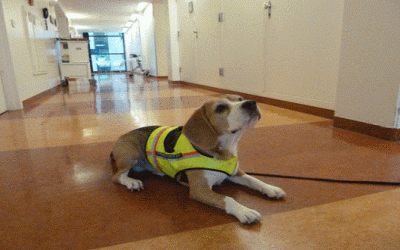Dog Trained to Sniff Out Clostridium difficile
A new study published in BMJ conducted by investigators at two large hospitals in The Netherlands shows that a trained dog was able to detect Clostridium difficile with high estimated sensitivity and specificity, both in stool samples and in hospital patients infected with C. difficile.


The detection dog. Courtesy of BMJ
A new study published in BMJ conducted by investigators at two large hospitals in The Netherlands shows that a trained dog was able to detect Clostridium difficile with high estimated sensitivity and specificity, both in stool samples and in hospital patients infected with C. difficile.
Bomers, et al. (2012) conducted this proof of principle study using a case-control design. A 2-year-old beagle was trained to identify the smell of C difficile and tested on 300 patients (30 with C difficile infection and 270 controls). According to the researchers, the dog was guided along the wards by its trainer, who was blinded to the participants infection status. Each detection round concerned 10 patients (one case and nine controls). The dog was trained to sit or lie down when C. difficile was detected.
Main outcome measures were sensitivity and specificity for detection of C difficile in stool samples and in patients. The dogs sensitivity and specificity for identifying C difficile in stool samples were both 100 percent (95 percent confidence interval 91 percent to 100 percent). During the detection rounds, the dog correctly identified 25 of the 30 cases (sensitivity 83 percent, 65 percent to 94 percent) and 265 of the 270 controls (specificity 98 percent, 95 percent to 99 percent).
Reference: Bomers MK, et al. Using a dogs superior olfactory sensitivity to identify Clostridium difficile in stools and patients: proof of principle study. British Medical Journal. December 2012; 345.
The Guardians of Animal Health: Who Are Veterinary Infection Preventionists?
March 21st 2025Veterinary infection control experts Leslie Kollmann, BS, AAS, CVT, CIC, Denise Waiting, LVT, and Leslie Landis, LVT, BS, discuss challenges, zoonotic disease risks, and the importance of education, collaboration, and resource development in animal care facilities.
The Latest on CLABSIs and CAUTIs: Evidence-Based Approaches for Infection Prevention
February 27th 2025Health care–associated infections like CLABSIs and CAUTIs threaten patient safety. Learn evidence-based strategies, new technologies, and prevention protocols to reduce these infections and improve outcomes.
Resilience and Innovation: The Pivotal Contributions of Black Americans to Health Care and Medicine
February 24th 2025During Black History Month, we honor the resilience and contributions of Black medical professionals in health care. Despite barriers, they have led transformative changes, advocating for equitable access and medical excellence. Recognizing their impact ensures a more inclusive health care future for all.
Glove Usage Guideline: From The Joint Commission, CDC, and World Health Organization
February 17th 2025Proper glove use is crucial in health care settings to prevent infections. Guidelines from TJC, CDC, and WHO stress correct selection, usage, and disposal to minimize health care–associated infections (HAIs) and cross-contamination risks. Infection preventionists (IPs) play a key role in educating staff, enforcing compliance, and improving patient safety through standardized glove practices.